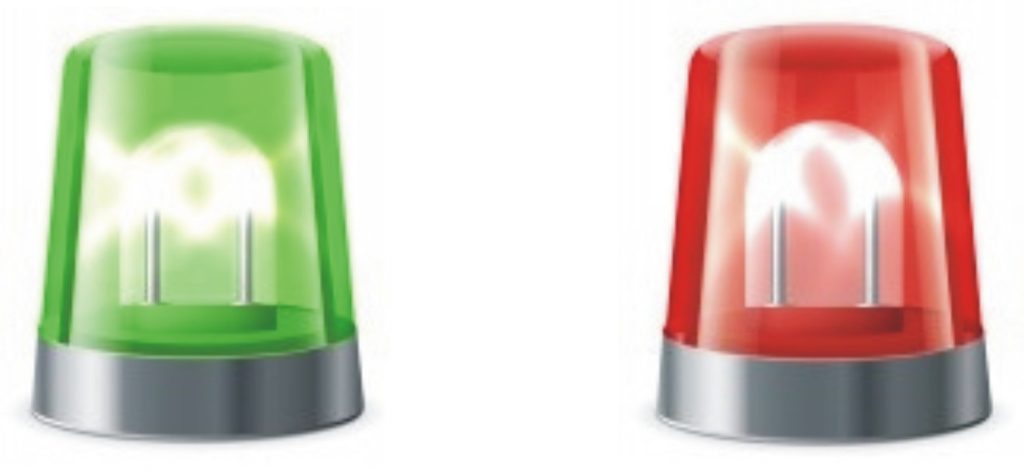- Hours of Operation
- Range Rules
- Safe Work Areas
- Range Safety Officer Commands
- Sighting in your Firearm
Hours of Operation
Rifle & Pistol Range Hours of Operation:
- Dawn to Dusk (except when the Trap Range is in use)
- Entry to the Range is by Key-fob only
Range Rules

| GREEN LIGHT | RED LIGHT |
|---|---|
| No ammunition or magazines on the Firing Line. You may handle ammunition or firearms behind the Safe Line. You may post targets and do other jobs down range. Those not going down range must stay behind Safe Line. | Eye and ear protection must be worn. Shooting is permitted. No one shall cross the Firing Line. Muzzle control must be maintained at all times. Loaded firearms will be aimed at the target at all times. |
- Safe Shooting is no accident.
- OBEY the Range Safety Officer.
- No ALCOHOL or CANNABIS Products
- Everyone must sign in using the log book provided.
- The Trap Range & the Rifle/Pistol Range can NOT be used at same time.
- Ranges are for use by members and invited guests ONLY. Members shall be responsible for ensuring that guests are aware of the Range Rules and supervise their actions!
- When more than one member is on the Range, those present shall appoint a Range Safety Officer (RSO). The RSO shall be responsible for the shooting activities on the Range, will control the lights and issue Range commands.
- When shooting, muzzle direction is under your control at all times.
- Keep the action of the firearm open at all times when not shooting.
- Loaded firearms on the Firing Line only. Loaded firearms must remain in hand.
| 50/100 YD Range | Handgun Range | |
|---|---|---|
| Permitted Firearms | Center Fire Rifles Shotgun (Slug or Sabot) Shotgun Patterning should be done on the Trap Range | Rimfire Rifles Handgun calibre up to .50 ca |
| Cease Fire | When a cease fire is called, all shooters stop, unload and step back. Follow directions of the RSO. |
| Ammunition | No tracer, incendiary or prohibited ammunition permitted at anytime. |
| Brass | Please pick up your spent casings when finished and dispose of in the appropriate supplied container. |
| Targets | Paper targets are to be used only on the club supplied target frames/holders. Steel reactive targets may be used when hung from the hooks in the bunker. NO tannerite targets or other targets to be used. |
| Rapid Fire | is not permitted on the ranges. 1 shot every 3 seconds in 5 shot strings for members. 1 shot every 5 seconds in 5 shot strings for guests. |
| REMEMBER OUR NEIGHBOURS ARE OUR FRIENDS AND FAMILIES! |
Safe Work Areas
- Long Gun Table
- Fumble Table (handguns)
- Live Ammunition is NOT permitted in the SAFE WORK AREAS

Range Safety Officer Commands

Sighting in your Firearm
Having a properly sighted in firearm is important. The following section provides guides for properly sighting in your firearms. Links are provided to additional information; these links are external and will open in a new tab/window.
1. Firearms with Iron Sights
If the sights are not aligned correctly, then the sights should be adjusted to bring the line of sight to meet the point of impact. It generally takes a number of shots to establish a group, then the sights are adjusted to move the line of sight closer to the group, and the process is repeated until the sights are correctly aligned.
Vertical Adjustment (Up and down):
If your shot is above your target using both sights facing directly at your target, the rear sight should be moved lower or your front sight should be moved higher. If your shot is below your target using both sights facing directly at your target, the rear sight should be moved higher or your front sight should be moved lower. Always remember: Move the rear sight in the same direction you want your point of impact to move & your front sight the opposite direction you want POI to move.
Horizontal Adjustment (Left and Right):
If your shot is left from your target using both sights facing directly at your target, the rear sight should be moved right or the front sight should be moved left. If your shot is right from your target using both sights facing directly at your target, the rear sight should be moved left or front sight should be moved right. Always remember: Rear same, front opposite that you want POI to move.

2. Firearms with Scopes
Telescopic sights are adjusted by clicks, representing minutes-of-angle (MOA). One MOA translates into approximately 1 inch (2.5 cm) at 100 yards (91.4 m). You must check your sight’s instruction manual to determine the correct number of clicks needed to properly adjust the sight.
If your scope requires 4 clicks to adjust the Point of Impact (POI) one inch at 100 yards (one MOA), then the following values will apply:
| Distance (Yards) | Adjust POI | Number of clicks |
|---|---|---|
| 100 | 1 inch | 4 |
| 50 | 1 inch | 8 |
| 25 | 1 inch | 16 |
| 20 | 1 inch | 20 |
